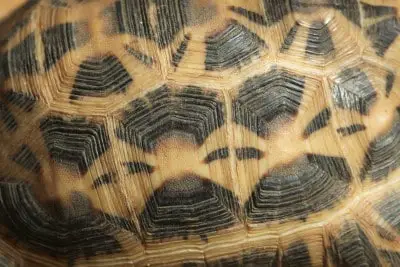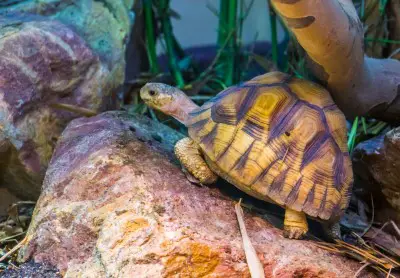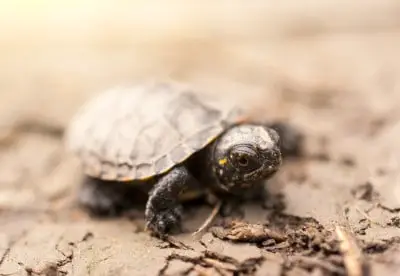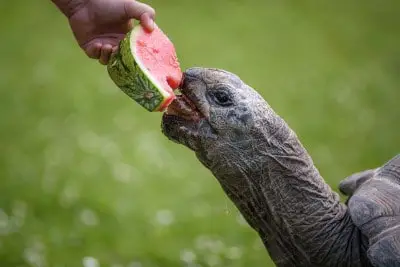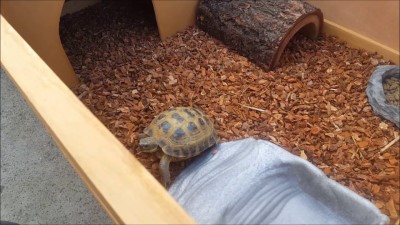Eyesight is vital for the survival of every creature and for the tortoises, it helps them look for food and evading predatory attacks. If you have a pet-reptile, reptile eyes are always interesting to learn about, given that their eyes are not front-facing like humans’. The following facts are all you need to know about the tortoises’ eyesight.

Are Tortoises Blind?
Tortoises can see well but not as clearly as humans. Their eyes are located in such a way that they have peripheral vision and can see what is in front of them. Their vision helps them locate objects on the ground, enabling them to move about during the day. Like other creatures, they entirely rely on eyesight to go about their activities.
It is crucial to help them see while hunting and in detecting when predators are approaching. In contrast, there are also cases of blind tortoises. They may hatch while blind or lose their vision when they get older, mainly due to infections.
The main reason behind tortoises turning blind is due to cataracts primarily resulting from hibernation. As much as there are known treatments for these conditions, they may be challenging to treat. When they become blind, you may find them immobile or with a distorted sense of direction. They also fail to respond to any visual stimuli and have problems with their appetite.
Thus, without vision, a tortoise will have to use the remaining senses such as hearing and touch to survive. Otherwise, its chances of survival are relatively slim compared to other tortoises. The condition is well-managed when the tortoise is in captivity since the owner can take full responsibility. However, if they lose sight while in the wild, it becomes tasking to survive.
What Should Tortoise Eyes Look Like?
The physical appearance of a tortoise’s eyes depends on its species. While most of them have bright or shiny black eyes, some, like the box turtles, have brown or orange eyes. It is essential to know how your tortoise’s eyes should look like, given its species, because, otherwise, something may be wrong, and you may need professional help.
Healthy eyes are clear without discharge, and the other eyelid should be slightly visible in the corner. Sometimes, their eyes can get teary, but it becomes an issue if it happens excessively. Their eyes should also be open unless they are sleeping.
If the eyes appear puffy or remain closed for a long time, there may be an issue. It is best to take them for medical attention as soon as possible if you notice any abnormalities. It would help if you opened the closed eye to determine what the issue is.
You can use warm water and cotton wool or a clean cloth to slowly open the lids, mostly if they have remained stuck due to hibernation. Note that the lower part of the eye is flexible, but the upper part is stuck.
Do Tortoises Have Eyelids?
Animals have eyelids that open and close during sleep or when blinking. These organs can also work involuntarily as a protective shield when a foreign object tries to enter the eye. They also close when the eyes get too dry to help moisten them. Tortoises have three eyelids, unlike most animals that have two. They have the lower and upper lids and an additional thin membrane to serve as the third eyelid.
The eyelids help them cover their eyes when resting or sleeping. Secondly, they are vital to protect the tortoise from eye injuries and guard them against dust and other air particles. The third eyelid is at the eye’s front corner, and it is difficult to see it unless you are keen as it crosses the eyeball.
However, you will quickly notice it if the tortoise has problems such as dehydration or eye infections. Once it gets affected, the aliment is severe in most cases. Again, a tortoise can have one or both eyelids swollen due to scratches, burns, or vitamin deficiencies. If these happen, it is paramount to contact a vet for further guidance.
Do Tortoises Have Eyebrows?
Only some mammals have hair around their eyes in the form of eyebrows and eyelashes. Their role is to form a barrier for the eyes to prevent sweat and other particles from getting into the eye. Hair is primarily found in mammals because their bodies are made of hair and fur to keep them warm due to their endothermic nature. However, reptiles, including tortoises and turtles, don’t have eyebrows.
Since they are ectothermic creatures, they don’t possess sweat glands that help in perspiration. Therefore, they don’t sweat like humans when it gets too hot. In the place of eyebrows, tortoises have protruded bony structures on the eyes. Reptiles do not have hair on their bodies as they don’t need it to keep warm. However, there are a few exceptions, such as some geckos that possess eyelashes.
How Far Can a Tortoise See?
The distance that an animal can see entirely depends on the strength of its eyesight and its height. The tortoise vision is restricted since it can only see what is close to the ground. The reptiles stare in front to see objects that are before them. However, they have a slight advantage over other creatures since they also have a slight peripheral vision thanks to their eyes’ location.
They can easily see what is approaching from their side without turning their heads, enabling them to be wary of their surroundings, especially when predators approach. Their eyes are not far on the side; hence, they mostly see their front. It helps them balance and walk straight, avoiding obstacles directly in their path.
On the contrary, the tortoise’s eyesight is not as advanced as the human vision; they don’t see images clearly, and they cannot see distant objects because their sight remains grounded due to their height. They are generally stout creatures; thus, their vision focuses on objects close to the ground. They will only see those that are near the ground and close to them.
How Well Can a Tortoise See?
Tortoises’ eyes are strategical, enabling them to have a great vision range because they can see in front and around them. They can quickly notice when something is moving, although they may not see it as clearly as you would. Given their few receptors per millimeter, they cannot differentiate objects using tiny details such as lines or cuts.
Interestingly, tortoises can see the ultraviolet range to some extent, unlike humans. With adaptation, the tortoises have evolved into seeing even under low light or complete darkness. They are also able to see some brightly-colored objects. All these factors combined show that the tortoise has well-adapted eyesight compared to other creatures.
Another advantage with their eyesight is that since anything they need is in their proximity, tortoises don’t need to crane their necks and struggle to see objects; they are content with looking for the available food on the ground.
Can Tortoises See Color?
This feature is one of the most debatable facts about the tortoise. Some owners are confident that their pets are attracted to some colors, while others don’t think their pets can differentiate any hues. One explanation is that the pets may love certain foods which happen to be of specific colors; hence, their preferences are only coincidental.
Similarly, some say that reptiles are attracted to some colors, especially bright ones like red. They also argue that this ability has, over the years, aided them while looking for food, especially brightly-colored wildflowers. Researchers say that tortoises have a high affinity to specific colors such as red, yellow, and orange.
Whenever they detect them, they immediately liken them to tasty food, and they may even try to take a bite to find out. Some findings suggest that the reptile can see the color spectrum, meaning that they can recognize and distinguish different colors.
Can a Tortoise See at Night?
Vision aids animals in hunting and detecting impending danger, meaning that it is necessary for their survival. Even when night falls, they still have to be cautious about their surroundings to be safe from predators. Over the years, tortoises have evolved to enhance their night vision capabilities; they can easily maneuver in the dark without bumping into things since their eyes have added rod cells.
The in-built cells enable them to detect the presence of objects even after the lights have gone off. Tortoises have night vision, but they hardly use it. They deploy the skill only during certain times as a last resort. The skill comes in handy when they need to look for food or escape from their enemies during the night.
However, their vision in the dark is incomparable to how their eyes work during the day. They use their eyesight more during daylight than when it’s dark because they can see images clearly when light shines on them.
It is quite a struggle for them to see in the dark as the images are blurred. Also, most tortoise species are diurnal, like humans, who spend a large part of the night sleeping and stay active during the day. Therefore, it is rare to find them crawling around at night.
Do Tortoises Blink?
This ability also depends on the tortoise species in question. While some can easily do it, others find it difficult or near impossible. Tortoises can blink just like other animals by moving their eyelids towards each other. It is common to find a tortoise species that cannot blink; therefore, you need not be alarmed if you never see your pet blinking because it is not a health-related issue.
The only problem comes in when the blinking becomes incessant. Typically, they blink after specific lengths of time. Otherwise, it will be best to consult a vet. The first reason for excessive blinking is when the tortoise has foreign particles in its eyes. As a result, it has to keep blinking to get rid of these substances.
You can help it by pouring water over its head or bathing them in warm water. Other times, tortoises blink when their enclosures’ humidity levels drop. If this is the case, it is crucial to moisturize the substrate or replace it with another one.
Do Tortoises Recognize Their Owner?
Although they are solitary animals, tortoises in captivity can find refuge and safety in their owners. It still debatable whether they can memorize their owner’s faces and recognize them when they come close. Their vision is not so clear; hence, we cannot precisely state that they can tell faces apart. The truth is they can associate their owner with food and, in the process, get fond of them. Similarly, since their hearing is not so clear, they can recognize vibration patterns from their owners. However, this can only happen after a while when they get to know you better.
Consequently, you may find them behaving differently toward people they keep seeing regularly. They primarily associate their owners with food. Hence, they are known to approach when their keepers come close. It takes some time before tortoises can open up to you.
You may notice that they seem withdrawn at first because they don’t show affection like other pets. If they are new pets, mostly, they may perceive you as a threat and crawl away from you or hide in their shell. The more time you spend with your pet, the more they will get used to your presence.
Are Tortoises Front-Facing Animals?
Tortoises are unique reptiles due to their ability to retreat into their shells. When they do this, their visual fields change, and their head remains in one spot, limiting their sideways vision. Therefore, their eyes become front-facing whenever they are in the shell.
On the other hand, they are typically side-eyed. Interestingly, they are a few creatures with stable vision even when facing front when in their shell. Tortoises also behave like front-facing creatures.
If you investigate their eyes separately, you would immediately think that they are from a front-facing animal without seeing how they work. Tortoises can move their eyes to see objects in their front and others in their peripheral line of vision. However, they are more adept at seeing objects in the front.
Do Tortoises Cry?
When you spend more time with tortoises, you will notice that they either have teary eyes or have tears streaming down their faces. When it is windy and dusty, foreign particles enter the tortoise’s eye. Therefore, they have to devise a means to repel them; hence their eyes get watery.
In the process, the liquid that drips from their eyes helps them eliminate the dust and other materials. They also “cry” when it is windy and dry, conditions that make their eyes dry. Crying helps them moisten their eyes by keeping them wet and hydrating them. Another reason for the crying is to help them balance the salt levels in their bodies.
The tears help them eliminate excessive unhealthy salt that the kidneys will otherwise not expel. Some people associate it with pain, but reptiles are not known to portray emotions.
Read more about Why Do Tortoises Cry.
Do Tortoises Get Eye Infections?
If tortoises don’t get proper nutrition or housing, they are susceptible to bacterial infections. These ailments can also occur even if you keep your pet under the best conditions. Without proper treatment, these eye infections can be severe and put your pet’s eyesight or life in danger.
Some owners may try to treat these conditions at home, but the best cause of action is to consult an expert about it first. The vet will then recommend antibiotics or other necessary remedies.
Eye infections might present themselves as white discharges or spots in your tortoise’s cornea. If untreated, the condition may spread to other areas of the eye leading to eye ulcers. The tortoise can also suffer from cataracts which cause swelling and irritation in their eyes.
They result from contamination in the water or low humidity. As an owner, it is best to keep a close eye on your tortoise because they are prone to eye problems that may be fatal. If there are any changes, the best you can do is contact a tortoise specialist for the way forward.
Finally
Tortoises have surprisingly good eyesight compared to other creatures. Although their vision is not as precise as human’s, they still have a reasonably wide range given their added advantage of a slight peripheral vision. They also possess incredible skills such as night vision and the ability to see some colors.
These and other abilities have enabled them to stand out among other animals. However, it would be best to be cautious about them since they are prone to eye infections that may be fatal without proper treatment. Hopefully, you have learned all you need to know about the tortoise’s eyesight and how best to care for them.
More tortoise facts here:

